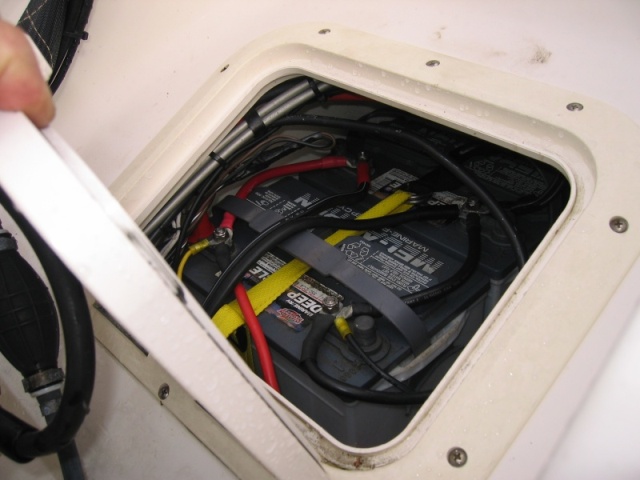| View previous topic :: View next topic |
| Author |
Message |
John S
Joined: 06 Jul 2006
Posts: 277
City/Region: Sterling
State or Province: AK
C-Dory Year: 2000
C-Dory Model: 24 Tomcat
Vessel Name: TomCat
Photos: TomCat
|
 Posted: Thu Oct 05, 2006 11:16 pm Post subject: House Battery Monitoring Posted: Thu Oct 05, 2006 11:16 pm Post subject: House Battery Monitoring |
 |
|
Was wondering what some of the other C-Dory boaters are doing to monitor their house batteries. We have two Interstate Deep Charge (class 24? I think) batteries wired in parallel and we make 3-5 day trips. How well can you do watching your voltage level, I'm assuming not accurate enough, as the deep cycles are built to hold their voltage until close to death.
I'm looking at the Link 10 from Xantrex?

You can see more on it at West Marine
http://www.westmarine.com/webapp/wcs/stores/servlet/producte/10001/-1/10001/21484/0/0/battery%20monitor/All_2/mode+matchallpartial/0/0
Has anyone ever installed one of these? How much trouble is it. I don't want to rewire the entire boat like some of you guys like to do.
So what do some of you folks that make overnight trips (without shore power and generators) do to know where you're at on your battery charge?
John |
|
| Back to top |
|
 |
thataway
Joined: 02 Nov 2003
Posts: 20812
City/Region: Pensacola
State or Province: FL
C-Dory Year: 2007
C-Dory Model: 25 Cruiser
Vessel Name: thataway
Photos: Thataway
|
 Posted: Thu Oct 05, 2006 11:40 pm Post subject: Posted: Thu Oct 05, 2006 11:40 pm Post subject: |
 |
|
I have used both the Link 10 and earlier predicessors which were multibattery with a large inverter charger. The advantage of the Link is that they give a good picture of the amount of current used, and replaced. Good monitering units for one battery.
I choose to use the Blue Seas single battery unit--and then put in a switch to read the voltage of 4 different batteries--two start, one electronics and one house. The Group 24 is a relitatively small battery--The 24 refers to the case size. There can be a spectrum of capacities of a group 24. Deep cycle does not really hold the voltage down to lower amount of discharge--this is pretty much of a given 12.2 volts steady state for 50% discharge (AGM is closer to 12.3 volts for 50% discharge). The heavier plates of deep cycle batteries, have slightly more amp hours and can withstand more cycles of discharge and charge.
I choose the two decimal point volt meter, with a lot of experience of battery monitering (and a separate rough amp meter)--but for the average boater and a single house bank, consider the Link 10. It is fairly easy to install--you have to be sure that all of the negitive power to and from that battery goes thru the one cable--and no bypass circuits--on this cable, you put a shunt, then a couple of sense wires. Plus hookups to the battery--not really difficult.
_________________
Bob Austin
Thataway
Thataway (Ex Seaweed) 2007 25 C Dory May 2018 to Oct. 2021
Thisaway 2006 22' CDory November 2011 to May 2018
Caracal 18 140 Suzuki 2007 to present
Thataway TomCat 255 150 Suzukis June 2006 thru August 2011
C Pelican; 1992, 22 Cruiser, 2002 thru 2006
Frequent Sea; 2003 C D 25, 2007 thru 2009
KA6PKB
Home port: Pensacola FL |
|
| Back to top |
|
 |
Dora~Jean
Joined: 09 Mar 2004
Posts: 1504
City/Region: Simi Valley
State or Province: CA
C-Dory Year: 2003
C-Dory Model: 25 Cruiser
Vessel Name: Dora~Jean
Photos: Dora~Jean
|
 Posted: Thu Oct 05, 2006 11:51 pm Post subject: Posted: Thu Oct 05, 2006 11:51 pm Post subject: |
 |
|
I'm a Link 10 believer, been using them on last three boats and also on our camping trailer. Real peace of mind. On my CD25 I have one for each of the two batteries, not much cost difference from the dual battery unit and I don't have to switch between them to view both -- just convenience.
As far as installation, you'll mount a 4" brass shunt (supplied) along a bulkhead near the battery which will monitor ALL of the negative post current into and out of the battery. If there are a lot of circuits going to that post, best to add a suitable terminal block to parallel the negative circuits. There are just a few small wires that lead from that shunt to the meter, you can buy a kit from Xantrex or just buy a generic multi-wire, stranded cable of the wire size they recommend (18 or 20 awg if I recall). Not difficult. Routing the wire from the stern to the dash is probably the hardest part, at least for me it was.
_________________
Steve & Carmen
"Great works are performed not by strength, but perseverance" (Samuel Johnson)
Dora~Jean C-Dory 25 2002-Present
Corsair F-31 Trimaran 1996-2002
MacGregor 26X 1988-1996
Glaspar Seafair Sedan 18 (2)
StarCraft 19 & 22
Catalina 17 & 22
Crestliner 19
+4 Previous, 1/2 sail, 1/2 power |
|
| Back to top |
|
 |
John S
Joined: 06 Jul 2006
Posts: 277
City/Region: Sterling
State or Province: AK
C-Dory Year: 2000
C-Dory Model: 24 Tomcat
Vessel Name: TomCat
Photos: TomCat
|
 Posted: Fri Oct 06, 2006 12:37 am Post subject: Posted: Fri Oct 06, 2006 12:37 am Post subject: |
 |
|
A couple questions; Is the link not appropriate for monitoring two batteries wired in parallell on the same bank? Do I need one for each battery  I currently have two house batteries and am considering adding a third house battery with cables running to my only empty battery shelf left in my other pontoon. (it would all be on the same bank) I currently have two house batteries and am considering adding a third house battery with cables running to my only empty battery shelf left in my other pontoon. (it would all be on the same bank)
So Bob, you only monitor your voltage on ThatAway? , I've seen the picture of your selector?
I am VERY concerned about where to mount this shunt or a terminal block, space is TIGHT. See my photo:
John
 |
|
| Back to top |
|
 |
Sea Wolf
Joined: 01 Nov 2003
Posts: 8650
City/Region: Redding
State or Province: CA
C-Dory Year: 1987
C-Dory Model: 22 Cruiser
Vessel Name: Sea Wolf
Photos: Sea Wolf
|
 Posted: Fri Oct 06, 2006 2:11 am Post subject: Posted: Fri Oct 06, 2006 2:11 am Post subject: |
 |
|
John S-
I believe you can use the monitor for two or three batteries wired in parallel, but only if you insert the shunt in the outgoing negative wire that carries all the combined electrical flow. Put another way, it must be in series with the combined three batteries with all the negative electrical current going through the shunt.
Then too, you'll have to set the amp hours in the monitor's memory to the combined two or three battieries' capacity. This assumes that the monitor will accept the added up total.
If space is tight, you can put the shunt in the negative lead anywhere, as long as all the current runs through it. Once the lead branches out, it won't work because there's more than one path and the shunt won't have all of the current flow running through it.
(Sorry to be so wordy, but it may eliminate some misunderstandings!)
Joe.
_________________
Sea Wolf, C-Brat #31
Lake Shasta, California
  
"Most of my money I spent on boats and women. The rest I squandered'. " -Annonymous |
|
| Back to top |
|
 |
Dora~Jean
Joined: 09 Mar 2004
Posts: 1504
City/Region: Simi Valley
State or Province: CA
C-Dory Year: 2003
C-Dory Model: 25 Cruiser
Vessel Name: Dora~Jean
Photos: Dora~Jean
|
 Posted: Fri Oct 06, 2006 2:43 am Post subject: Posted: Fri Oct 06, 2006 2:43 am Post subject: |
 |
|
Yes, all of the current must go through the shunt in order for the Link 10 to properly monitor the current in and out of the battery or bank of batteries. Parallel the batteries then put the shunt in series with the lead heading to the loads -- and the charging source (motor); that's right, the outboard must also be connected so that the charging and starter currents (same cable) goes through the shunt.
The shunt generates no measurable heat, it is mounted only to stabilize the small wires connected to it that go to the meter. Therefore, you could probably figure out a way to shrink-wrap, tie-wrap or otherwise stabilize the wires to follow a cable bundle until it joins the pack going to the cabin.
One final comment, I generally don't like paralleling batteries. Each battery has slightly different characteristics (internal resistance, charge/discharge efficiency, etc), which leads to the possibility as they age that they will 'fight' each other and could actually boil the electrolyte/water solution right out of one of them. I've seen it happen. A better way to gain capacity is to place two large 6V golf cart batteries in series, then there's no possibility of electrical incompatibility or contention. Just my 2c. |
|
| Back to top |
|
 |
John S
Joined: 06 Jul 2006
Posts: 277
City/Region: Sterling
State or Province: AK
C-Dory Year: 2000
C-Dory Model: 24 Tomcat
Vessel Name: TomCat
Photos: TomCat
|
 Posted: Fri Oct 06, 2006 3:18 am Post subject: Posted: Fri Oct 06, 2006 3:18 am Post subject: |
 |
|
Interesting that all the negatives must be brought together, it makes sense. But.....
My negative leads are:
-Outboard starter
-Jumper from Port Starting Battery (Only switched on during starboard battery jump off to start starboard motor)
-Cable to accessories at the dash
-Pot Puller
-Cable to parallel wire the batteries
-Windlass
Would it really be possible to gang these all together and connect them to the shunt? Is there enough room? I have both negative threaded terminals on the batteries pretty well loaded up to the highest level I feel comfortable, as it is. The photo above is pretty self evident. Would it work?
Steve, I understand your concerns about batteries, somewhere I read, maybe in the C-Dory manual, that the deep cycle house batteries should be replaced at the same time when wired this way. Undoubtedly, one will go out before the other some day though. |
|
| Back to top |
|
 |
Sea Wolf
Joined: 01 Nov 2003
Posts: 8650
City/Region: Redding
State or Province: CA
C-Dory Year: 1987
C-Dory Model: 22 Cruiser
Vessel Name: Sea Wolf
Photos: Sea Wolf
|
 Posted: Fri Oct 06, 2006 7:10 am Post subject: Posted: Fri Oct 06, 2006 7:10 am Post subject: |
 |
|
John S-
"Would it really be possible to gang these all together and connect them to the shunt? Is there enough room?"
This is a mechanical problem to overcome. We have described what must be done for the electrical device (Link 10) to work. Wheather it's practical considering the physical/mechanical difficulties involved with the limited space is your decision.
I'd try to connect all the leads you mention above to a very large bus, and then connect a line from the bus to the shunt, then more lines branching out from the other end of the shunt to the batteries. Won't be easy.
Maybe there's another solution that would be more practical in your situation?
*************************************************************************
For those interested, the shunt/Link 10 works like a recording/calculating ammeter and therefore becomes a battery monitor.
The shunt wired in series is necessary to measure all the current flowing into and out of the batteries. Almost all of the current runs through the shunt with it's very low resistance.
The meter (Link 10), is connected in parallel with the shunt. It has a very high resistance. If the shunt has a resistance of 1 ohm and the Link 10 circuit 9999 ohms, then 99.99% of the current runs through the shunt, and 0.01% goes through the Link 10.
The Link 10 knows this ratio (9999:1), and calculates the real current flow.
It then compares the cumulative current flow in and out of the batteries with the known amp-hour capacities (which you set) of the batteries to show you the remaining amp-hour capacity.
It also shows you battery voltage which is also a function of the state of charge.
Note that this is a somewhat over-simplified explanation of what must be happening, but it allows you to better understand how the Link 10 works.
Hope this is useful.
Joe. |
|
| Back to top |
|
 |
Dora~Jean
Joined: 09 Mar 2004
Posts: 1504
City/Region: Simi Valley
State or Province: CA
C-Dory Year: 2003
C-Dory Model: 25 Cruiser
Vessel Name: Dora~Jean
Photos: Dora~Jean
|
 Posted: Fri Oct 06, 2006 10:37 am Post subject: Posted: Fri Oct 06, 2006 10:37 am Post subject: |
 |
|
Joe, yep, you got it. Hey, maybe you and I could open up a side business selling Link 10's and provide after-sales service installation tips, etc?? Hmmmm.
One more tidbit on the shunt. It is a bar of brass, very low resistance. Across the length between the screws that go to the meter, 500 amps of current produces 50 millivolts of voltage. Thus, the current is translated to voltage linearly. 5 amps produces 1/100th of that voltage or 0.50 millivolts (500 microvolts), and so on. The meter is essentially a computer that senses this current continuously, and the voltage AT THE BATTERY TERMINALS (no drop due to any loads except for the battery's internal resistance). These current and voltage measurements are integrated over time to measure the power being consumed or injected continously. We could go into Purkert's equations and battery efficiency in the next lesson...unless you've already gone to sleep! |
|
| Back to top |
|
 |
John S
Joined: 06 Jul 2006
Posts: 277
City/Region: Sterling
State or Province: AK
C-Dory Year: 2000
C-Dory Model: 24 Tomcat
Vessel Name: TomCat
Photos: TomCat
|
 Posted: Fri Oct 06, 2006 11:20 am Post subject: Posted: Fri Oct 06, 2006 11:20 am Post subject: |
 |
|
| Sea Wolf wrote: |
"Would it really be possible to gang these all together and connect them to the shunt? Is there enough room?"
This is a mechanical problem to overcome. We have described what must be done for the electrical device (Link 10) to work. Wheather it's practical considering the physical/mechanical difficulties involved with the limited space is your decision. |
I've never seen the shunt, mechanically I don't know what it can handle. All I get is a pretty picture of the face of the device. Although ultimately it is my "decision" I REALLY hope a TC24 owner or previous owner has already come up with a solution to my tight fit, highly loaded battery terminal situation and will post the practical solution. (preferably without taking over the fish box) 
I appreciate the better understanding of how a Link 10 works, it's nice to have it narrowed down to a quality product to get the job done. Now I just need a 24TC owner or two who have intstalled one to help me wrap this up so that I can place my order.
John |
|
| Back to top |
|
 |
John S
Joined: 06 Jul 2006
Posts: 277
City/Region: Sterling
State or Province: AK
C-Dory Year: 2000
C-Dory Model: 24 Tomcat
Vessel Name: TomCat
Photos: TomCat
|
 Posted: Fri Oct 06, 2006 12:20 pm Post subject: Posted: Fri Oct 06, 2006 12:20 pm Post subject: |
 |
|
I did a little searching, this certainly seems to be what I need, the one with the 5/16 studs, now figuring out where to mount it.
John
 |
|
| Back to top |
|
 |
journey on
Joined: 03 Mar 2005
Posts: 3595
City/Region: Valley Centre
State or Province: CA
C-Dory Year: 2005
C-Dory Model: 25 Cruiser
Vessel Name: journey on
Photos: Journey On
|
 Posted: Fri Oct 06, 2006 12:22 pm Post subject: Posted: Fri Oct 06, 2006 12:22 pm Post subject: |
 |
|
I had a link 10 on the sailboat, and it worked great. However the price has doubled to ~$200. I now use an analog voltmeter ($20,) with an input switch. When the voltage gets down to 12 vdc, time to recharge. Connected directly to each battery bank, so the reading is at the battery and no bus bar is needed.
Does anyone know where to get the equivilant to a link 10 at ~$100? That would make it worthwhile.
Also, Interstate deep cycle batteries are good for about 200 cycles, 9 mos at a daily cycle. I found this out the hard way. I switched to golph cart batteries, which one can install on a CD25. Any other deep cycle battery suggestions?
The southern Boris |
|
| Back to top |
|
 |
thataway
Joined: 02 Nov 2003
Posts: 20812
City/Region: Pensacola
State or Province: FL
C-Dory Year: 2007
C-Dory Model: 25 Cruiser
Vessel Name: thataway
Photos: Thataway
|
 Posted: Fri Oct 06, 2006 2:34 pm Post subject: Posted: Fri Oct 06, 2006 2:34 pm Post subject: |
 |
|
I am also really big on Golf carts--We have had them in the Cruising sail boats and trawlers and RV's. Usually 3 to 4 groups of 2 6 volt batteries. However in the C dory and Tom Cats, this puts a lot of weight aft--and we have elected to have at least one AGM group 31 foreward (may have two). I don't have a probelm with two similar type and age (for example if I had two lifeline AGM of approximately the same age, the interaction is minimal)
I agree with the buss bars you have pictured--exactly what we have used--get the one with the small terminal strip and two 5/16 or 3/8 studs on the ends. You should be able to find some area which is only 3 x 5" for this terminal strip and shunt. You may want to mount a piece of wood in this area, and then take the single cable from the battery to the shunt, then the buss bar, and all of the other wires off the buss bar. I have a friend with a 24 TC down the street and probably could ask him where to put the buss bar. |
|
| Back to top |
|
 |
thataway
Joined: 02 Nov 2003
Posts: 20812
City/Region: Pensacola
State or Province: FL
C-Dory Year: 2007
C-Dory Model: 25 Cruiser
Vessel Name: thataway
Photos: Thataway
|
 Posted: Fri Oct 06, 2006 6:48 pm Post subject: Posted: Fri Oct 06, 2006 6:48 pm Post subject: |
 |
|
| I discussed this with my neighbor (and maybe he will chime in here) who owns a Tom Cat 24. He feels that if you take out the battery, and stick your head in there (His words)--that you will see that there is room for the shunt and buss bar in the lazarette area. Hook up the shunt and buss bar, then put the battery back in--with only one cable to the positave and one cable to the negitive buss bars/shunt. |
|
| Back to top |
|
 |
John S
Joined: 06 Jul 2006
Posts: 277
City/Region: Sterling
State or Province: AK
C-Dory Year: 2000
C-Dory Model: 24 Tomcat
Vessel Name: TomCat
Photos: TomCat
|
 Posted: Sat Oct 07, 2006 3:06 am Post subject: Posted: Sat Oct 07, 2006 3:06 am Post subject: |
 |
|
Bob,
This is good news, I was hoping to hear some TC24 guy had figured it out. Could you get him to be more specific about how and where he mounted it in there. I'm still new to screwing and drilling fiberglass and still trying to figure out what to bolt all the way thru with a backing plate and what things I should use a screw for. Do you know if he found room for both a negative and positive buss?
Moving on to the necessity of the Link 10. How many of you guys think just watching the voltage level is accurate enough? I know the 737 I fly just has a minimum battery voltage specified for starting the Auxiliary Power Unit (APU). Can this principal be used on my boat also. "The Southern Boris" you have used both the link 10 and just watching the voltage. Did you find a direct correlation between a specific battery voltage and the state of charge on your batteries when you were using your link 10?
Bob, I'm not sure I understand exactly what you are using now, are you monitoring voltage ONLY at this point on your boat with your rotary switch?
If lots of people are finding voltage monitoring sufficient (although not specific) I would rather spend the $300 or so in monitor, busses and wiring toward a Honda 1000W generator instead, which I think I will end up needing anyway.
Thanks for all the help,
John |
|
| Back to top |
|
 |
|
|
You cannot post new topics in this forum
You cannot reply to topics in this forum
You cannot edit your posts in this forum
You cannot delete your posts in this forum
You cannot vote in polls in this forum
You cannot attach files in this forum
You cannot download files in this forum
|
|

 Search
Search Private Messages
Private Messages Profile
Profile Log in
Log in Register
Register Help
Help






